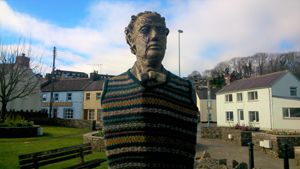
Cockle Factory
In a pleasant garden by the car park a wooden sculpture of Dylan stares at the castle.
Pictured above in a sleeveless pullover as part of 2014's NTW play Raw Material: Llareggub Revisited.
This was where an 18th century granary once stood, latterly used as a warehouse, and more recently as the Cockle Factory before being demolished in the 1970s.
You can see it as a derelict building below, as published in The Observer in 1967. Before the granary, a Dutch medieval windmill and steam-mill stood on this site.
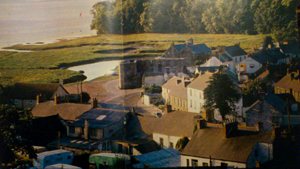
Cockles were separated from the sand by riddling at the water's edge and then tipped into sacks.
As the tide came in the cocklers rowed or walked home where the washing process would continue.
By 1925 the cocklebeds were dying out, no longer accessible by foot or donkey, only small boats.
Cockle women used to scrape the cockle with a piece of iron, with some old rag or string as a handle.
Then they riddled them and packed them in bags which they then washed again. Some people laid the bags for the estuary to wash them.
The cockle factory packed them up and sent them on carts and later lorries to the station in St Clears where they were put on trollies and weighed.
Some were sold in Laugharne and farms further afield using hand carts.
Dylan Thomas famously wrote about Laugharne's, '...web-footed cockle-women' in a 1934 letter to his then girlfriend, Pamela Hansford Johnson.
He went on to say (rather unkindly) that '... I can never do justice to the shapes of the fisherwomen's breasts as they drop, big as barrels as they bend over the sand...
each muscle on the legs as big as a hill.'
Laugharne was a famous cockling town for centuries, but the cockle beds naturally moved across Carmarthen Bay towards Pembrey and the cockle factory
closed in 1954 when Laugharne's Les Parsons moved his business, Parsons Pickles to Burry Port.
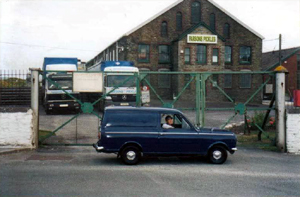
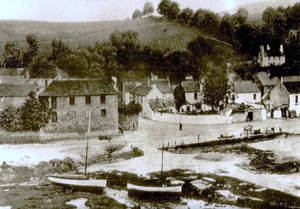
Alongside the warehouse lay an ancient chapel, known as the Mariner's Chapel.
It had a stoup and a piscina, which indicates its pre-Tudor, catholic origins. Such chapels were erected in ports for mariners to pray for a fair journey,
and to give thanks for their safe return.
In the 18th century the chapel was used by the Moravian Calvinist church and Peter Williams preached here from time to time.
It later fell into disuse and was used as a storehouse, and in 1880 only its ivy-coloured walls remained.
According to the 1909 map, it was attached to the building and therefore can be seen in the pic above, just to the right of the warehouse.
To get a sense of perspective the building facing the Cockle Factory on the right (The old Three Horseshoes pub at the end of Frogmore St) is circled below.
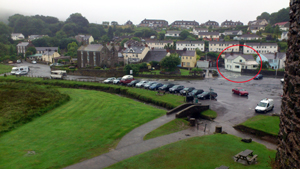
Below is a 1963 painting of the Cockle Factory by local artist Stanley Lewis (Upton House). The chapel building has an orange roof and was probably used as a store room.
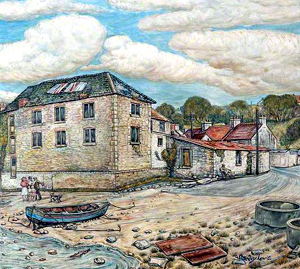
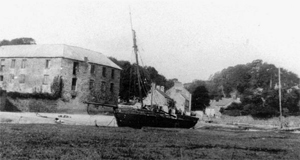
The first pic shows a boat roughly where the centre of the car park is now. And the pic below shows a WW1 Victory carnival in 1919 where you can see the water. The car park floods regularly and then we get a glimpse of what it would have looked like before the Tarmac was put down in the 50s. Also the turning to the right is clearly very narrow. Recently several massive tank transporters headed to the military base on the marsh, passing The Vicarage and Great House in the pic. They certainly wouldn't have navigated that bend! (Pic by Denize Macintyre)
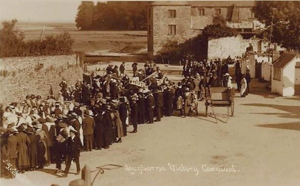
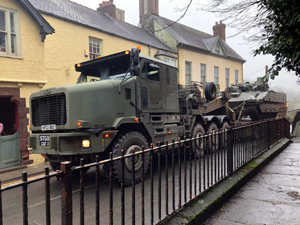
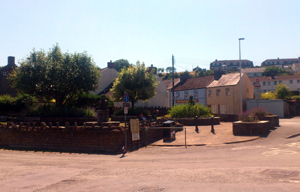
The scene today. Were the stones from the cockle factory used in the garden walls?
Awelrydd Davies in 1904 wrote, '...cockle dealers (about twenty-five in number), reside for the most part, in Frog St and the Grist, whilst a few reside in Gosport St.
Cocklers are an honest, upright and industrious class of people.'
Today only one cockle-picker still resides in Laugharne, or just outside.
Barry Cockles (not his real name) sets off at all hours to gather up the sea's harvest of cockles and 'weed', or laverbread, but don't ask him where, as he is very secretive.
In April 2020 he was collecting laverbread 'down west'. This was during the first Covid lockdown.
He went back to his van, the only vehicle parked in the car park to find a police officer standing by his van.
'Is this your van?' asked the officer.
'Well there's no f*cker else around here!' answered Barry.
'What are you doing?'
'I'm collecting laverbread.'
The copper looked puzzled. 'What's that?'
So Barry was fined, but the CPS threw the case out as the SeaFish agreement covered collecting laverbread during lockdown.
copyright © 2021 Laugharne Lines
all rights reserved